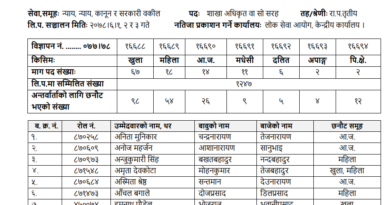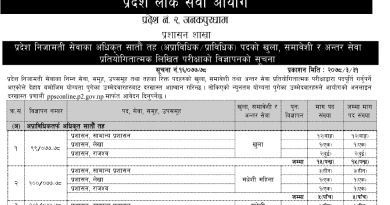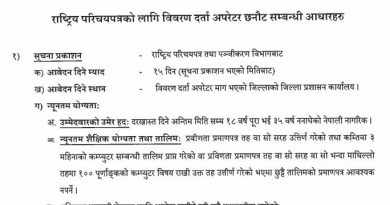Bagmati Pradesh Loksewa Aayog Syllabus
The Bagmati Pradesh Loksewaa aayog Provincial Public Service Commission) has made public the syllabus of local and provincial fifth level technical and non-technical posts. You can download the syllabus from the website of Bagmati Pradesh Loksewa aayog.
Check Here in Syllabus Loksewa Aayog Syllabus
spsc.gov.np


Engineering Service Civil Group Building & Architect 5th Level Sub Engineer Post Course |
Part I Civil Engineering
1. Drawing
1.1 General
1.1.1 Importance, aims and objectives of drawing
1.1.2 Drawing equipments
1.1.3 Architectural discipline
1.1.4 Standard drawing sheets sizes
1.1.5 Drafting techniques and methods in common practice
1.1.6 Scales: Choice, use and conversion
1.2 Measured Drawing
1.2.1 Methods of measurement of horizontal and vertical dimensions
1.2.2 Sectional measurements
1.2.3 Dimensioning of sketches
1.2.4 Checking for missing details in field
1.3 Working Drawing
1.3.1 Role of working drawing
1.3.2 Interrelationship with estimate and specification
1.3.3 Construction detailing in plan and section
1.3.4 Significance of detailing in terms of accuracy of estimation, bill of quantities and construction supervision
1.3.5 Working drawing for private and public buildings, sanitary installation, electrification
1.3.6 Structural working drawings
2. Estimating and Costing
2.1 General
2.1.1 Purpose of estimating
2.1.2 Main items of work
2.1.3 Units of measurement and payment of various items of work and materials
2.1.4 Degree of accuracy
2.1.5 Standard estimate formats of Government of Nepal
2.1.6 Data for estimate
2.1.7 Preliminary estimate
2.1.8 Approximate quantity estimate
2.1.9 Detailed estimate
2.1.10 Revised estimate
2.2 Rate Analysis
2.2.1 Manufactures’ cost
2.2.2 Transportation cost
2.2.3 Overheads
2.2.4 Need for contingencies
2.2.5 Use of Government Rate Analysis Norms
2.3 Specifications
2.3.1 Purpose
2.3.2 Types
2.3.3 Necessity
2.3.4 Interpretation of Specifications
2.4 Estimating
2.4.1 Earthwork
2.4.2 Estimate of buildings
2.4.3 Estimate of sanitary installations
2.4.4 Estimate of electrical wiring and sanitary works
2.4.5 Annual maintenance
2.5 Valuation
2.5.1 Purpose of valuation
2.5.2 Methods of valuation
2.5.3 Standard formats used for Property Valuation in Nepal
3. Management
3.1 Organization
3.1.1 Need for organization
3.1.2 Building agencies
3.1.3 Structure of the Department of Urban Development and Building construction
3.1.4 Responsibilities of a building sub engineer
3.1.5 Relation between owner, contractor and consultants
3.2 Accounts
3.2.1 Familiarity with related Nepalese accounting system
3.2.2 Administrative approval and technical sanction
3.3 Planning and Control
3.3.1 List of activities
3.3.2 Construction schedule
3.3.3 Equipment and materials schedule
3.3.4 Construction stages and operations
3.3.5 Bar Chart
3.4 Municipal Building By-laws
3.4.1 Sheet sizes
3.4.2 Scales
3.4.3 Setback
3.4.4 Height controls
3.4.5 Other requirements specifies by the municipalities
3.4.6 FAR
4. Building Service
4.1 Water Supply
4.1.1 General principle of water supply
4.1.2 Water requirement standard for different buildings
4.1.3 Storage and distribution of water
4.1.4 Heating of water, storage and distribution requirements
4.2 Disposal system
4.2.1 Septic tank, soak pit, vent and manhole
4.2.2 Pipes for different sewage
4.2.3 Incinerators
4.3 Electricity
4.3.1 General principles of electrical installation and distribution
4.3.2 Wiring systems in private and public building
4.3.3 Ducts for electrical distribution
4.3.4 Safety precautions
4.4 Lighting
4.4.1 General principles of lighting
4.4.2 Illumination requirements and standards
4.4.3 Combination of artificial and natural light
4.4.4 Lighting fixtures
Part II Building
5. Surveying
5.1 General
5.1.1 Primary divisions of survey
5.1.2 Classification based on instruments and on methods
5.1.3 Basic principle of surveying
5.1.4 Scales, plans and maps
5.1.4 System of field booking of surveying and levelling data
5.1.5 Theodolite survey
5.2 Levelling
5.2.1 Classification of levelling work
5.2.2 Methods of levelling
5.2.3 Levelling instruments and accessories
5.2.4 Principles of levelling
5.2.5 Temporary and permanent adjustments of a level
5.2.6 Profile levelling
5.2.7 Booking and reducing levels
5.3 Errors and their effects
5.3.1 Kinds of errors
5.3.2 Source of errors in chaining, levelling, plane tabling and compass surveying 5.3.3 Effects of errors
5.4 Plane Tabling
5.4.1 Equipments used
5.4.2 Working operations
5.4.3 Methods of plane tabling
5.4.4 Merits and demerits of plane tabling
5.5 Contouring
5.5.1 Definitions of terms
5.5.2 Use contour maps
5.6 Setting out
5.6.1 Small buildings
5.6.2 Simple curves
5.6.3 Locating the boundaries of farm lands
6. Construction Materials
6.1 Stone
6.1.1 Rocks and their characteristics
6.1.2 Formation and availability of stones in Nepal
6.1.3 Quarrying: excavation, Wedging and blasting
6.1.4 Methods of laying and construction with various stones
6.2 Aggregates
6.2.1 Fine aggregates
6.2.2 Coarse aggregates
6.2.3 Availability and practice in Nepal
6.3 Cement
6.3.1 Different cements: ingredients, properties and manufacture
6.3.2 Storage and transport
6.3.3 Admixtures
6.4 Metals and Alloys
6.4.1 Wrought iron: Properties, use
6.4.2 Steel: composition, properties, appearance, strength, constructional forms and manufacture
6.4.3 Corrosion and its prevention
6.4.4 Brass: uses
6.5 Brick
6.5.1 Type
6.5.2 Manufacture
6.5.3 Laying
6.5.4 Availability and practice in Nepal
6.6 Lime
6.6.1 Manufacture
6.6.2 Types and properties
6.6.3 Uses
6.7 Paints and Varnishes
6.7.1 Type and selection
6.7.2 Preparation techniques
6.7.3 Uses
6.8 Floor Finishes
6.8.1 Punning
6.8.2 Tiles: mosaic, clay, concrete, vinyl
6.8.3 Marble and flagstones
6.8.4 Wooden boarding and parqueting
6.9 Wall Finishes
6.9.1 Plasters: cement, lime, mud
6.9.2 Punning: cement, lime
6.9.3 Cladding: wood, stone, tiles
6.10 Roofing Materials
6.10.1 Clay tiles, ceramic tiles and states
6.10.2 CGI and UPVC
6.11 Miscellaneous Materials
6.11.1 Glass
6.11.2 Plastics
6.11.3 Asphalt and Bitumen
6.11.4 Surkhi
7. Structural Design
7.1 Timber Structures
7.1.1 Allowable stresses
7.1.2 Design of compression members
7.1.3 Design of solid rectangular beams, design of simple steel beams
7.1.4 Types of joints and their connections
पाठ्यक्रमु
7.2 Steel Structures
7.2.1 Rivetted and welded connections: types, uses, detailing
7.2.2 Detailing of simple roof trusses
7.2.3 Detailing of rolled steel beams
7.2.4 Detailing of column bases
7.3 R.C. Sections in Bending
7.3.1 Basis assumptions
7.3.2 Position of neutral axis
7.3.3 Moment of resistance
7.3.4 Under reinforced, over reinforced and balanced sections
7.3.5 Analysis of singly and doubly reinforced rectangular sections
7.3.6 Analysis of singly reinforced flanged sections
7.4 Shear and Bond for Reinforced Concrete (RC) Sections
7.4.1 Behaviour of R.C. section in shear
7.4.2 Shear resistance of R.C. section
7.4.3 Types of shear reinforcement and their design
7.4.4 Local and anchorage bond
7.4.5 Determination of anchorage length
7.4.6 Bar curtailment
7.5 Axially Loaded R.C
7.5.1 Short and long columns
7.5.2 Design of a rectangular column section
7.5.3 Reinforcement detailing
7.6 Design and Detailing of R.C Structures
7.6.1 IS code requirements
7.6.2 Methods of design
7.6.3 Singly reinforced T and L beams
7.6.5 Simple one-way and two-way stabs
7.6.6 Simple pad footings for columns
7.6.8 Preparation of bar bending for RC design
7.7 Earthquake Resistant Design of Non-engineered Structures
7.6.1 History of Earthquake in Nepal and damages
7.6.2 Weakness of existing building
7.6.3 Site consideration
7.6.4 Building form, shape and size
7.6.5 Size and location of openings
7.6.6 Selection of materials
7.6.7 Construction technology
7.6.8 Seismic resistant components : through stone, vertical and horizontal reinforcement, diaphragm, boxing of building, lateral restrainers, unsupported length of wall, corner and junction of wall/connection of building components
8. Building Construction Technology
8.1 Foundations
8.1.1 Function and necessity
8.1.2 Subsoil exploration: test pit
8.1.3 Safe bearing capacity of soils and its improvement
8.1.4 Type and suitability of different foundations: shallow, deep (pile and well)
8.1.5 Methods of excavating
8.1.6 Shoring and dewatering
8.1.7 Elements of simple spread foundation
8.1.8 Stone masonry foundations
8.1.9 Raft foundation
8.2 Walls
8.2.1 Types of walls: solid wall, partition wall, cavity wall, curtain wall
8.2.2 Features and their functions
8.2.3 Types of stone masonry: rubble, hammer dressed and ashlars masonry
8.2.4 Brick Masonry: English, Flemish, garden rat trap, monk
8.2.5 Types of concrete blocks
8.2.6 Choosing wall thickness, height to length relation
8.2.7 Use of scaffolding
8.2.8 Procedure of constructing various masonry walls
8.3 Damp Proofing
8.3.1 Source of dampness
8.3.2 Remedial measures to prevent dampness
8.3.3 Vertical and horizontal damp proofing
8.3.4 Damp proofing materials
8.4 Concrete Technology
8.4.1 Constituents, mixing and use of lime concrete
8.4.2 Constituents, of cement concrete
8.4.3 Grading of aggregates
8.4.4 Concrete mixes
8.4.5 Water cement ratio
8.4.6 Workability
8.4.7 Concrete laying
8.4.8 Factors affecting strength of concrete
8.4.9 Form work
8.4.10 Vibrators
8.4.11 Curing
8.4.12 General introduction to Precast RC units
8.4.13 Hydration and segregation
8.5 Wood Work
8.5.1 Frame and shutters of doors and windows
8.5.2 Timber construction of upper floors
8.5.3 Design and construction of stairs
8.5.4 Double timber roofs
8.5.5 False ceiling
8.5.6 Sky-light: elements, functions and construction details
8.6 Steel Work
8.6.1 Steel work in windows: Standards, elements and functions
8.6.2 Tubular and angle steel roofs
8.6.3 Iron grill and lattice work
Part III Architecture –Maintenance of building
9. Building Design
9.1 Analysis of Building Elements
9.1.1 Bed
9.1.2 Kitchen/Dining
9.1.3 Living Hall
9.1.4 Class Room
9.1.5 Working Office Space
9.1.6 Library
9.2 Design Consideration
9.2.1 Specific program: space requirements
9.2.2 Site: topography, orientation, environment
9.2.3 Functional relationship between activities
9.2.4 Culture: tradition, values, taste
9.2.5 Economics: efficient use of space and materials
9.2.6 Availability to technology and material
9.2.7 Structure type and efficiency
9.2.8 Optimum use of natural light and ventilation
9.2.9 Aesthetics
9.3 Climatology
9.3.1 Climate: sun, wind, rain, humidity
9.3.2 Orientation of the building with respect to the sun and wind: best, optimum, bad
9.3.3 Determination of length of roof projection to act as sunshade
10. Architectural Modelling
10.1 Modelling Materials and Practices
10.1.1 Use of models
10.1.2 Choice of materials
10.1.3 Modelling techniques
10.1.4 Accuracy of models
10.1.5 Determination of degree of detailing
10.1.6 Model construction of multi-storey buildings
10.1.7 Contour models of sites
10.2 Equipments Required
10.2.1 Choice of cutting tools
10.2.2 Choice of adhesives
10.2.3 Choice of colour and tone
10.2.4 Choice of paint and brushes
10.2.5 Miscellaneous tools
11. G r a p h i c s a n d p r e s e n t a t i o n
11.1 Principles of Composition
11.1.1 Balance
11.1.2 Scale
11.1.3 Rhythm
11.1.4 Monotony
11.1.5 Contrast
11.1.6 Unity
11.1.7 Focal point
11.2 Tone
11.2.1 Light
11.2.2 Medium
11.2.3 Dark
11.2.4 Flat
11.2.5 Graded
11.3 Free Hand Works
11.3.1 Drawing lines
11.3.2 Drawing letters
11.3.3 Three dimensional objects
11.4 Presentation
11.4.1 Textures
11.4.2 Exterior and interior objects
11.4.3 Human figures
11.4.4 Shadows
11.5 Medium for Presentation
11.5.1 Pencil techniques
11.5.2 Colour history and type: pencil colour, water colour, Poster colour
11.5.3 Primary, secondary and tertiary colours
11.5.4 Warm and cool colours
11.5.5 Properties of colour
11.5.6 Colour circle
11.5.7 Colour scheme: monochromatic, analogous, complementary and triad
11.6 Data Presentation in Graphical Forms
11.6.1 Translation of numerical data into diagrams and vice versa
11.6.2 Pie chart, bar chart and XY graphs
11.7 Cartography
11.7.1 Tracing of land-use maps
11.7.2 Presentation of land-use maps


